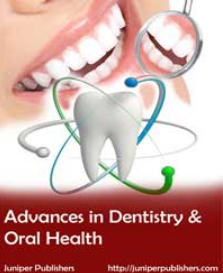A Mysterious Disease - Osteonecrosis of the Jaw- Juniper Publishers
Juniper Publishers- Open Access Journal of Dentistry & Oral Health
Abstract
The concept and technique of the pinhole surgical procedures has been a debated topic in dentistry in recent years. This paper consists of a mini review of the literature available on pinhole surgical technique. This review shows that pinhole surgical technique allows us to reposition the gums quickly and easily, with the less invasive method, a decreased patient discomfort, a shorter treatment and recovery time and much less pain.
Keywords: Osteonecrosis of the jaw; Dental status; Radiotherapy; Bisphosphonate; Multifactoria
Introduction
Osteonecrosis of the jaw (ONJ) is defined as a painful lesion with exposed bone in maxilla, mandible, or both which fails to heal within 8 weeks after appropriate treatment [1].
ONJ is a silent disease because it presents as asymptomatic bone exposure without significant soft tissue infection in its early stage. However, the infected necrotic maxillofacial lesion with ulcerated swollen oral mucosa and chronic sinus tract derived from ONJ usually attack the life quality of patients [2]. The pathogenesis and risk factors of ONJ is a controversial issue until now and there is no superior and appropriate strategy for this intractable illness. Although the head and neck irradiation and bisphosphonates (BPs) administration are widely accepted as the major risk factors of ONJ [3], our recent study had indicated the dental status significantly impacts on the ONJ development [4,5].
Radiotherapy
The irradiation exposure on the head and neck region usually induces prominent cellular changes and oral tissue dysfunction [6]. Permanent salivary gland damage could be happened if accumulative doses exceed 30 Gy [7]. Osteoradionecrosis (ORN- radiation related necrosis) of the jaw is a common complication in head and neck cancer patients and its incidence is about 1-30% [8]. Because radiotherapy alters the oral condition, head and neck cancer patients are regarded as a high-risk group to develop ORN.
Based on the consensus proposed by National Institutes of Health, head and neck cancer patients are suggested to receive oral and dental evaluation and treatment before radiotherapy or chemotherapy [9]. Our study proposed in 2017 preliminarily indicated pre-radiotherapy dental prophylaxis is strongly correlated to ORN. It is best to avoid chlorhexidine exposure and dental scaling within two weeks before radiotherapy. That will significantly raise the ORN risk, especially in oral cancer patients. The cautious prescription of chlorhexidine mouth rinse and proper timing of scaling can effectively reduce the incidence of ORN [5].
Bisphosphonate and osteoporosis
Bisphosphonate-related osteonecrosis of the jaw (BRONJ) is a drug side-effect involving progressive destruction and necrosis in the alveolar bone [10]. The variable incidence of BRONJ ranges from 2.5% to 27.3% and most reported cases occurred in cancer patients [11]. Previous study indicated ONJ is a rare complication if BPs use is less than 5 years [12]. The osteoporosis patients with longer duration and higher dosage of BPs used have significant excess risk for ONJ [4] although the correlation of the BRONJ and the cumulative dosage of BPs is still a controversial issue now. It is essential to discover the best way of BPs administration based on a favorable risk-benefit ratio in the high-risk fracture population.
Clinicians should be aware the profits of BPs against the risk of BRONJ then define the optimal duration of treatment remains.
Dental Status
Many Previous study both in human and animal models revealed that periodontitis raises the risk of ONJ development and the 84% patients with BRONJ were suffered from periodontitis [13]. Oral hygiene status and the history of dental procedure are highly related to ONJ [14]. Yuh et al. [15] had represented dental extraction plays a significant influence on the ONJ development [15]. This consensus is coincident to the viewpoint we proposed in 2015, there is a close association with annual frequency of dental extraction and ONJ occurrence [4]. Dental status is closely associated with the ONJ occurrence and good oral hygiene maintenance plays the key role in preventing ONJ.
Conclusion
ONJ is a multifactorial disease. Osteoporosis, radiotherapy and past dental history play the major effect in some ways and BPs is the synergistic role. Appropriate treatment plan for BPs administration after analyzing every risk factor may reduce the risk of ONJ.
Osteoporosis patients with BPs used had higher risk of ONJ if they received more than twice dental extraction annually. It is essential to examine oral condition for active or anticipated dental issues prior to BPs treatment or radiotherapy. Clinicians should be vigilant for ORN occurrence under chlorhexidine mouth rinse exposure or dental scaling within two weeks prior radiotherapy. Good oral hygiene maintenance to avoid the frequent dental extraction may be the supreme principle to prevent ONJ.
For more Open Access Journals in Juniper Publishers please click on: https://juniperpublishers.com/aboutus.php
For more articles in Open Access Journal of Dentistry & Oral Health please click on:
To know more about Open Access Journals please click on: https://juniperpublishers.com/journals.php


Comments
Post a Comment